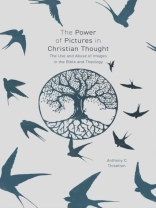A biblical, historical and theological investigation into the tendency of literary images to either enlighten or mislead, and how we can learn to distinguish between the two.
Part One considers key philosophical and aesthetic evaluations of literary images and symbols. The power of pictures is widely appreciated, as in the adage ‘a picture is worth a thousand words’. Sometimes Christian discourse can be smothered by endless prose, which demands much inferential reasoning. There is, however, a contrary argument. An isolated visual representation can be misleading if it is improperly interpreted. For example, some mystical visions are interpreted as direct instructions from the Holy Spirit, as happened with the Radical Reformers, who advocated the Peasants’ Revolt. Hence theories of symbol, metaphor, and visual representation must be examined.
Part Two discusses visual representation in the Old Testament, the teaching of Jesus, pictures and analogies in Paul, and the Book of Revelation. This shows the range of authentic visual representations. In contrast to biblical material, we find throughout Christian history abundant examples of misleading imagery which is often passed off as Christian. A notorious example is found in the visual representation and metaphors used by Gnostic writers. Almost as bad are some visual representations used by the medieval mystics, Radical Reformers, and extreme charismatics – all of which lack valid criteria of interpretation, relying instead on subjective conviction. Similarly, sermons and prayers today can be enriched with pictorial images, but some can be misleading and unhelpful for the life of the Church.
表中的内容
Part 1
PHILOSOPHICAL, HERMENEUTICAL AND LITERARY
1 The power of pictures, visual images and symbols 3
One picture is worth a thousand words 3
Visual representation from Plato to Descartes and today 7
Pictures, symbols and archetypes: emotions and participation 14
2 The seduction of pictures and images under certain conditions 25
Negative reactions to ‘the picture theory of language’ 25
The debate about aspects or ‘points of view’ in hermeneutics 30
The captivating power of pictures when seen as ‘part of our language’ 36
3 Pictures, metaphors and symbols 39
Types of metaphors: ornamental, creative and interactive 39
Negative theories of metaphor: Nietzsche and Derrida 43
The cognitive power and extra-linguistic reference of
metaphors: Ricoeur and Soskice 46
4 Interpreting pictures and visual images 52
System as an interpretative frame 52
Tradition and texts as interpretative frames 55
Convention as an interpretative frame: popular notions 58
Part 2
BIBLICAL PICTURES, SYMBOLS AND IMAGES
5 Visual pictures and symbolic acts in the Old Testament 69
The development of symbols and symbolic acts in the Old Testament 69
Symbols for God: God’s character and actions, and the covenant 74
Symbolic visual representation and symbolic animals and plants 79
6 Pictures and images in the teaching of Jesus
Everyday rural Galilean life: the power of Jesus’ vivid visual imagery
Truth-claims of the parables of Jesus and their varied interpretations
The parables as poetic metaphor: Wilder, Funk, Crossan, Via and others
7 Pictures and analogies in the earlier letters of Paul: 1 Thessalonians, Galatians and 1 Corinthians
Paul’s earliest epistle: 1 Thessalonians
The Epistle to the Galatians
1 Corinthians: Paul’s most plentiful examples
8 The later letters of Paul: from 2 Corinthians to the Pastoral Epistles
Paul’s metaphors in 2 Corinthians and Romans
Analogies in Philippians, Philemon, Colossians and Ephesians
Pictures and images in the Pastoral Epistles
9 Pictures, symbols and images in the book of Revelation
Pictures and images in Revelation: their varied interpretation
The theocentric character of the pictures and images of Revelation
Pictures and images in the remainder of Revelation
Part 3
COMMUNICATION IN HISTORY AND TODAY
10 Pictures and symbols in post-biblical sources and Christian communication today
Pictures and symbols in some Church Fathers and in Gnostic writings
Twelve mediaeval and post-mediaeval mystics, and claims about visions in the Pentecostal and Charismatic movements today
The need for, and danger of, visual communication in the Church today 214
关于作者
Anthony C. Thiselton is Emeritus Professor of Christian Theology at the University of Nottingham. His recent publications include Approaching Philosophy of Religion (2017), Discovering Romans (2016), Systematic Theology (2015), The SPCK Dictionary of Theology and Hermeneutics (2015), and The Holy Spirit (2013), all published by SPCK.







![的封面 Brian Schrag & Julisa Rowe: Community Arts for God's Purposes [Chinese] 貼近神心意的社群藝術 的封面 Brian Schrag & Julisa Rowe: Community Arts for God's Purposes [Chinese] 貼近神心意的社群藝術](https://static.worldofdigitals.com/thumb_webp/740/9781645083740.webp)




